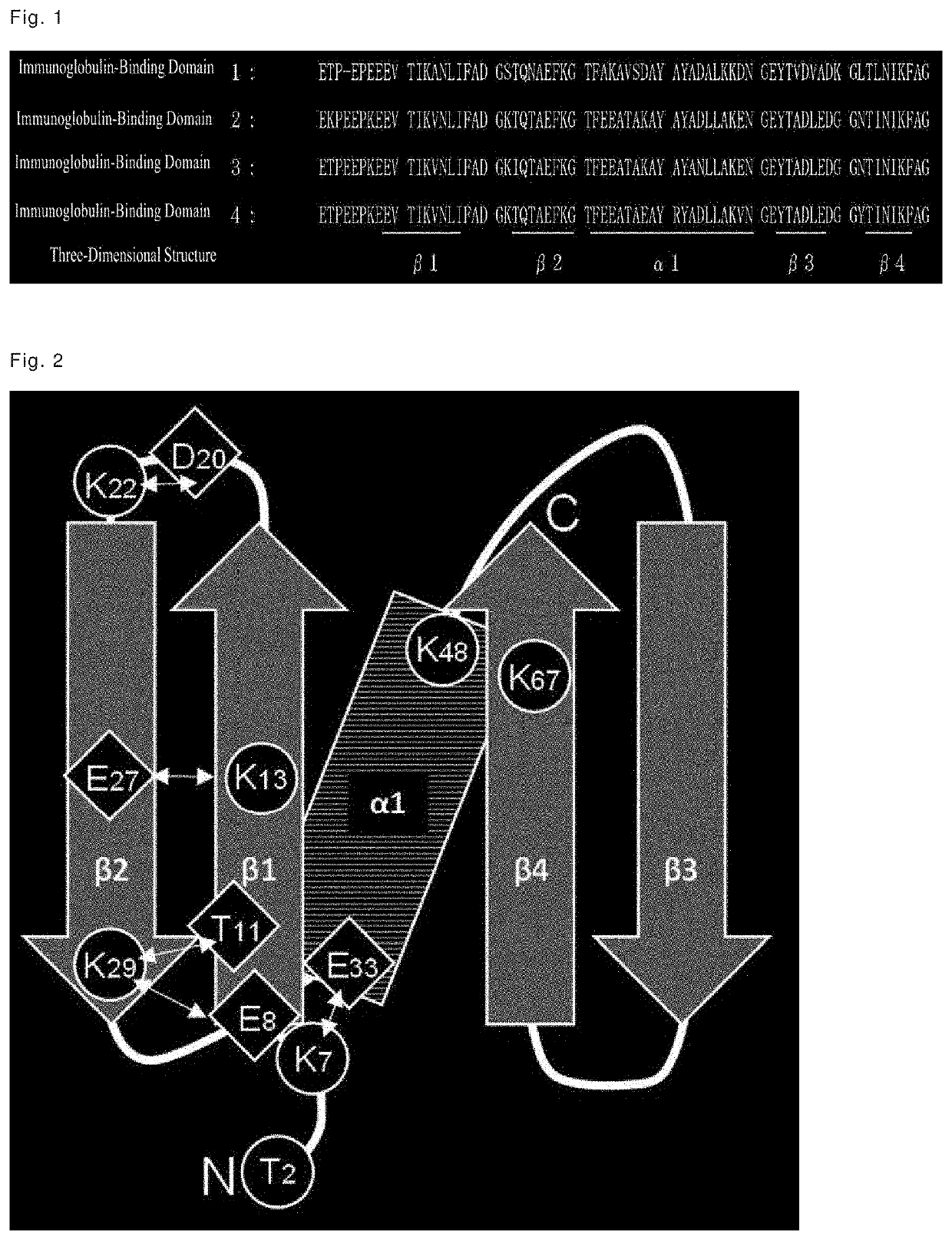Immunoglobulin-binding polypeptide
a polypeptide and immunoglobulin technology, applied in the field of polypeptides, can solve the problems of insufficient research on the technology of imparting alkali stability to protein l, and has never been clarified what kinds of modifications are needed, so as to reduce the binding capacity of an immunoglobulin, reduce costs, and increase binding capacity
- Summary
- Abstract
- Description
- Claims
- Application Information
AI Technical Summary
Benefits of technology
Problems solved by technology
Method used
Image
Examples
referential example 1
Production of Immunoglobulin-Binding Domain Proteins of Protein L Derived from Peptostreptococcus magnus, and Evaluation of Binding Capacity and Alkali Stability
[0142][Production of Immunoglobulin-Binding Domains]
[0143][Design and Construction of Modified Products]
[0144]A chimeric protein containing immunoglobulin-binding domain 1 was designated as PL-021, a chimeric protein containing immunoglobulin-binding domain 2 was designated as PL-022, a chimeric protein containing immunoglobulin-binding domain 3 was designated as PL-023, and a chimeric protein containing immunoglobulin-binding domain 4 was designated as PL-014.
[0145][Preparation of PL-014 Expression Plasmid]
[0146]Initially, DNA fragment A1 (the first-half of immunoglobulin kappa light chain-binding domain 4) was prepared by PCR using synthetic oligo-DNAs oligo-166 (SEQ ID NO: 8) and oligo-167 (SEQ ID NO: 9) having about 15 bases at the 3′ end complementary to each other, as templates for each other. Similarly, DNA fragment A...
example 1
Production of Modified Products of Immunoglobulin-Binding Domain 4 and Evaluation of Binding Capacity and Alkali Stability
[0169][Production of Modified Products]
[0170]With the aim of further improving the alkali stability, immunoglobulin-binding domain 4 having high immunoglobulin binding capacity and high alkali stability was used as a basic sequence to prepare modified products thereof having amino acid substitutions, with a focus on a total of eight amino acid residues, i.e., the threonine residue at position 2, and the seven lysine residues at positions 7, 13, 22, 29, 48, and 67, in immunoglobulin-binding domain 4.
[0171][Design and Construction of Modified Products]
[0172]Domain 4 was used as a basic sequence to prepare modified products thereof, wherein the threonine residue at position 2, and the seven lysine residues at positions 7, 13, 22, 29, 48, and 67 shown in Table 3 were substituted.
[0173][Preparation of PL-024 Expression Plasmid]
[0174]Initially, a modified product PL-02...
example 2
Production of Multidomain Polypeptides of Modified Product of Immunoglobulin-Binding Domain 4 and Evaluation of Binding Capacity and Alkali Stability
[0201][Construction of Multidomain Polypeptide Expression Plasmids and Protein Expression]
[0202]The DNA sequence of a modified product PL-024 chimeric protein contains a translation initiation codon having Ndel recognition sequence (CATATG) and a sequence encoding an artificial N-terminal sequence “MAQHDEAGLAL”, followed by a sequence encoding a modified domain of the immunoglobulin kappa light chain-binding domain of Protein L, and EcoO109I recognition sequence (GGGGCCT) in a sequence encoding an artificial sequence “NIKFAGAL” at the C-terminus, and further contains 21 residues of the modified C-terminal sequence of the third α-helix of the immunoglobulin Fc-binding C-domain derived from Protein A, and lastly contains a sequence encoding an artificial C-terminal sequence “KKK”, as well as a translation stop codon and BamHI recognition ...
PUM
| Property | Measurement | Unit |
|---|---|---|
| pH | aaaaa | aaaaa |
| temperature | aaaaa | aaaaa |
| temperature | aaaaa | aaaaa |
Abstract
Description
Claims
Application Information
 Login to View More
Login to View More - R&D
- Intellectual Property
- Life Sciences
- Materials
- Tech Scout
- Unparalleled Data Quality
- Higher Quality Content
- 60% Fewer Hallucinations
Browse by: Latest US Patents, China's latest patents, Technical Efficacy Thesaurus, Application Domain, Technology Topic, Popular Technical Reports.
© 2025 PatSnap. All rights reserved.Legal|Privacy policy|Modern Slavery Act Transparency Statement|Sitemap|About US| Contact US: help@patsnap.com

